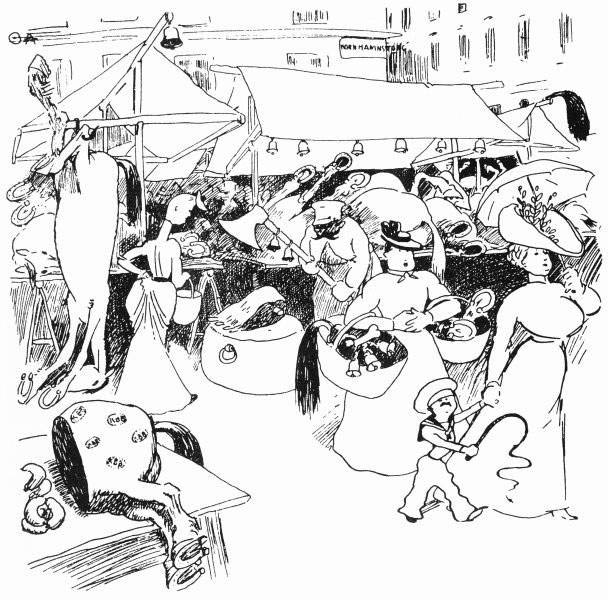'Mannen Som Gör Vad Som Faller Honom In'.
Oskar Andersson, who signed with his well-known signature OA, was a late 19th-century, early 20th-century Swedish comic artist. He is regarded as one of the pioneers in Swedish comics, known for his absurd, dark comedy style. The man drew various caricatures, one-panel gag cartoons but also actual comic series. His best known series were the anarchistic 'Mannen Som Gör Vad Som Faller Honom In' ('The Man Who Does Whatever Comes To His Mind', 1902-1906) and the gag-a-day comic 'Urhunden' (early 1900s). While his comics career only lasted a mere nine years (1897-1906) before his tragic early death, Andersson's influence on Swedish comics has been huge. The artist is often referred to as the first known Swedish comic artist, but caricaturists like Johan Tobias Sergel, Carl August Ehrensvärd, Pehr Nordquist and Fritz Von Dardel already made sequential stories in the 18th and 19th century. Andersson was, however, the first to create comic series with recurring characters, and the first to have a major impact.
"When electrical transport replaces horseback riding".
Early life and career
Oskar Emil Andersson was born in 1877 in Kungsholmen, not far from Stockholm. His father worked at AB Myntverket, a company that manufactured coins and medals. Andersson studied arts, crafts and design at Konstfack university in Stockholm, after which he followed in his father's footsteps. One of his fellow students was the famous sculptor Carl Milles. At the age of twenty, Andersson sold some of his cartoons to the Swedish humor weekly Söndags-Nisse magazine. The editors were convinced of his talent, and hired the young artist as a regular contributor. He filled the vacancy left by Albert Engström, who had just launched his own humor magazine Strix. By 23 September 1897, Andersson's drawings also appeared in this publication. He often signed with his initials, O.A. When asked why he did this, Andersson reportedly said: "I don't need to sign my drawings, I'll recognize them right away".
'Broderne Napoleon ach Bartholomeus Lunds fran Gronkoping resa jorden runt'.
Broderne Napoleon & Bartholomeus Lunds
Andersson initially made only caricatures and illustrations. He found inspiration in the American newspaper comics of the time, like James Swinnerton's 'Little Bears', R.F. Outcault's 'The Yellow Kid' and Rudolph Dirks' 'The Katzenjammer Kids', and started making sequential narratives as well. Andersson was the first in Sweden to produce actual comic series, with recurring characters. The first of these was called 'Broderne Napoleon ach Bartholomeus Lunds fran Gronkoping resa jorden runt' ('The world trip of Napoleon and Bartholomeus Lunds from Gronkoping', 1898). It starred two brothers who have all kinds of absurd adventures in exotic countries. The work was published in Söndags-Nisse and stands out for being the author's only adventure comic, consisting of 117 images.
'Mannen som gör vad som faler honom in' (1902).
Mannen Som Gör Vad Som Faller Honom In
Söndags-Nisse editor Hasse Z was a mentor and close friend of Andersson, and the two men regularly went to pubs together. Andersson's lack of social skills often made him a laughing stock. The artist was incredibly shy and filled with frustrations. His drawings became his outlet, in which he could do whatever he wanted and fully express himself. This was especially evident in the pantomime comic 'Mannen Som Gör Vad Som Faller Honom In' ('The Man Who Does Whatever Comes To His Mind'), of which Andersson made about 20 episodes between 1902 and 1906. In this comic strip, all of the protagonist's actions are opposed to the principles of morals and mechanization. For instance, when he shakes hands with someone he dislikes, he cuts off his fingers afterwards. When it stops raining, he throws his open umbrella to the ground and he enjoys watching a dynamiting site at close proximity.
Urhunden
In the early 1900s, Andersson created another famous comic strip, 'Urhunden'. It featured a prehistoric man in modern surroundings who owns a pet dinosaur and calls the animal an "ancient dog". The reptile often causes mayhem for which it is punished afterwards. The series was popular enough to inspire both a magazine, Urhunden (1973-1976) and the establishment of the Urhunden Prize in 1987, an annual comics award.
Final years and death
After a while, Andersson's drawings weren't enough to fight off his depressions. By 1906, the artist illustrated news events for the newspaper Dagens Nyheter. On one instance, he stayed in Linkoping for a week with the journalist Erik Nyblom (A.K.A. Mac) to report on a military operation where, for the first time in Sweden, contemporary weapons were used. He however managed to only complete two drawings, because he was so depressed by the military's brutal behavior and how badly they treated their horses. Rumors went around that the artist was in a mental hospital when he returned to Stockholm. However, he stayed with his parents in Ekerö. The final months of his life were filled with regular violent rages. On 28 November 1906, Oskar Andersson cut his writsts and then shot himself. He died instantly. According to legend, the shy artist wanted his tombstone to read "Here rests O.A.", but it was not approved by the cemetery board.
'Mannen som gör vad som faller honom in'.
Legacy and influence
There have been at least four memorial exhibitions about Oskar Andersson: in 1916, 1920, 1931 and 1944. On the occasion of the 100th anniversary of his birth in 1977, the Swedish postal services released a series of stamps dedicated to his work. One of the Swedish cartoonists who is mostly inspired by Oskar Andersson is Oscar Hjelmgren. His strip 'En ful fisk' ('An Ugly Fish') can be considered a modern rendition of Andersson's 'Mannen som gör vad som faller honom in' and even features guest appearances by O.A.









